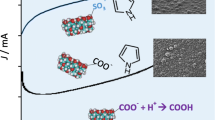Abstract
Nitrobenzene was found dissimilar to 1,2-dichloroethane and chloroform in electrodeposition of electronically conducting polypyrrole at a water/organic solvent junction by means of the three-phase electrode. Morphologies of the two sides of the potentiostatically deposited, freestanding thin polymer films differ distinctly which might be of interest for specific applications. A low temperature of the synthesis at the liquid–liquid junction is preferable for attaining the homogeneous surface morphologies of the polymer films.






Similar content being viewed by others
References
Ouyang J, Li Y (1997) Effect of electrolyte solvent on the conductivity and structure of as-prepared polypyrrole films. Polymer 38:1971–1976
Tietje-Girault J, Ponce de Leon C, Walsh FC (2007) Electrochemically deposited polypyrrole films and their characterization. Surf Coat Technol 201:6025–6034
Patois T, Lakard B, Monney S, Roizard X, Fievert P (2011) Characterization of the surface properties of polypyrrole films: influence of electrodeposition parameters. Synth Met 161:2498–2505
Carquigny S, Segut O, Lakard B, Lallemand F, Fievet P (2008) Effect of electrolyte solvent on the morphology of polypyrrole films: application to the use of polypyrrole in pH sensors. Synth Met 158:453–461
Li M, Zhu H, Mao X, Xiao W, Wang D (2013) Electropolymerization of polypyrrole at the three-phase interline: influence of polymerization conditions. Electrochim Acta 92:108–116
Bąk E, Donten M, Skompska M, Stojek Z (2006) Electrodeposition of poly(N-vinylcarbazole) at the three-phase junction. Formation of very different polymer structures. J Phys Chem B 110:24635–24641
Vignali M, Edwards RAH, Serantoni M, Cunnane VJ (2006) Electropolymerized polythiophene layer extracted from the interface between two immiscible electrolyte solution: current-time analysis. J Electroanal Chem 591:59–68
Reymond F, Fermin D, Lee HJ, Girault HH (2000) Electrochemistry at liquid/liquid interfaces: methodology and potential applications. Electrochim Acta 45:2647–2662
Sadki S, Schottland P, Brodie N, Sabouraud G (2000) The mechanism of pyrrole electropolymerization. Chem Soc Rev 29:283–293
Lacroix JC, Maurel F, Lacaze PC (2001) Oligomer-oligomer versus oligomer-monomer C2-C2’ coupling reactions in polypyrrole growth. J Am Chem Soc 123:1989–1996
Lee S, Sung H, Han S, Paik W (1994) Polypyrrole film formation by solution-surface electropolymerization: influence of solvents and doped anions. J Phys Chem 98:1250–1252
Grzeszczuk M, Chmielewski M (2012) Influence of electrodeposition potential on composition and ion exchange of polypyrrole films in aqueous hexafluoroaluminate featured by EQCM molar mass to charge factors. J Electroanal Chem 681:24–35
Fisher Scientific, Pyrrole (2014). http://www.fishersci.com/ecomm/servlet/fsproductdetail_10652_648561__-1_0
Chmielewski M, Grzeszczuk M, Kalenik J, Kępas-Suwara A (2010) Evaluation of the potential dependence of 2D-3D growth rates and structures of polypyrrole films in aqueous solutions of hexafluorates. J Electroanal Chem 647:169–180, and references therein
Grzeszczuk M, Kalenik J, Kępas-Suwara A (2009) Phase boundaries in layer-by-layer electrodeposited polypyrrole resulted from 2D-3D growth of polymer sublayers. J Electroanal Chem 626:47–58
Riddick JA, Bunger WB, Sakano TK (1986) Organic solvents—physical properties and methods of purification. 4th edition in Techniques of chemistry, vol II. Wiley, New York
Kaczorowski Z, Figaszewski ZA, Petelska AD (2011) Elektrochemia cieczowych granic fazowych. Wydawnictwa Uniwersytetu Warszawskiego, Warszawa
Author information
Authors and Affiliations
Corresponding author
Rights and permissions
About this article
Cite this article
Wójcik, K., Grzeszczuk, M. Surface morphology of thin polypyrrole films electrodeposited along aqueous electrolyte–organic liquid interface. Influence of temperature and solvent. J Solid State Electrochem 19, 1293–1300 (2015). https://doi.org/10.1007/s10008-015-2750-x
Received:
Revised:
Accepted:
Published:
Issue Date:
DOI: https://doi.org/10.1007/s10008-015-2750-x



